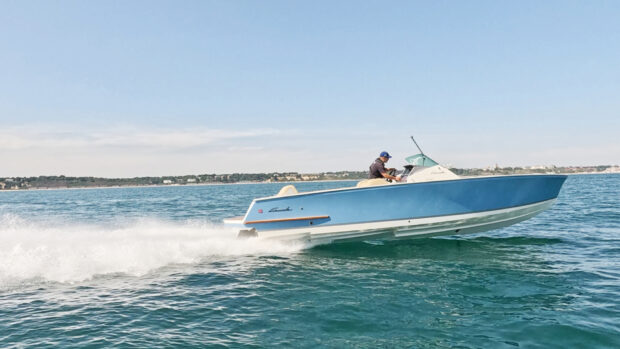Polishing a boat is an arm-aching but ultimately very satisfying task. Our resident boating instructor Jon Mendez explains how to polish your boat…
What many people don’t realise is that that boat polish isn’t just an aesthetic nicety, it’s also a vital extra layer of protection for the gelcoat that forms the outer skin of your boat’s hull and superstructure.
A GRP surface, especially one that has been allowed to get dirty or chalky, looks like the surface of the moon when viewed under a microscope, with pitting, small craters and other surface irregularities that encourage further degradation.
Some of this is inevitable as the gelcoat gradually fades and wears over time but you can help counter this by regular cleaning, polishing and, if needed, careful use of a cutting compound to remove the worst of those surface imperfections.
The polishing part is particularly important as it fills in any minor surface irregularities, preventing dirt, dust and other air or waterborne contaminants from settling in the microscopic dips. A second coat of polish gives further protection and helps maintain the shine by encouraging water to run off.
The amount of cutting back and polishing depends on how poor the existing surface is. A very chalky dull finish would suggest that it hasn’t been polished for a while. If left untreated this can lead to longer term damage which would require serious cutting back or even repainting.
Article continues below…

How to antifoul your boat: The best way to protect your hull from fouling

Ceramic Pro review: Can this ultra-tough coating seal a boat for life?
Areas with rust marks around stanchions bases or cleats and algae staining around the waterline are best treated first with an oxalic acid cleaner such as Y10 gel that can be applied with a brush and left for 15 minutes before being hosed off.
How to polish your boat
For a routine polish, the normal process is to wash the boat with a mild detergent to remove surface contamination, grease, and grime, then assess whether it needs cutting back with an aggressive cutting compound or whether a much milder all-in-one cutting/polishing product will suffice.
Our test boat, which has a partly blue hull that shows every mark, needed a moderate cut back all over with extra attention to the blue parts, followed by a milder cutting/polishing compound that would restore the shine and protect it.
Coloured gelcoats, particularly dark blue or red ones, tend to show any chalkiness earlier than white ones, so you may need to polish these areas at least twice a year.
If polishing by hand, which I prefer for small areas, you’ll just need one soft cloth to rub the polish in and another clean cloth to remove it. If using a mechanical polisher, then you’ll need an applicator head and a separate polishing one.
The most important rule of using a mechanical polisher is not to allow the surface to get too hot. Keep the speed of the head slow and use a water bottle or spray to dampen the surface as you move along. Follow this with two applications of a pure wax polish to leave a good shine and protect the cleaned surface underneath.
On this 30ft (9m) boat the whole process took the best part of two short winter days, taking care to wear overalls, gloves and safety glasses when using the mechanical polisher.
Access to all parts of the boat was possible with a simple two-step ladder but larger craft may require longer ladders or even a platform to maintain a safe working height. Once the whole process is finished, it’s good practice to rinse the boat off to remove any residue and leave it ready for launching.
Check out YBW’s guide to the best boat wax and polish










